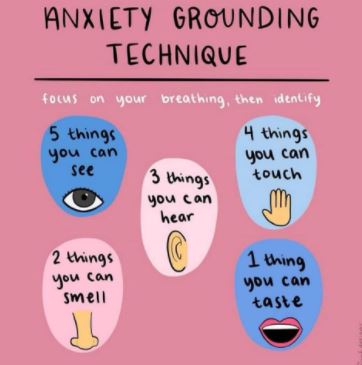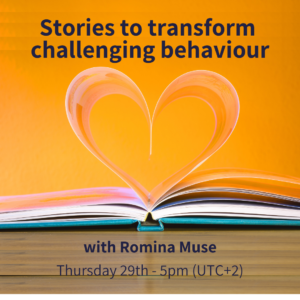It was such a pleasure to have Romina Muse join us in the Hub for the webinar this week. Romina is passionate about working with young learners and using stories to develop their emotional literacy. Romina started off by sharing two different images of challenging behaviour: on the one hand, an incident of bullying and on the other, a child who is very withdrawn. It was really interesting listening to Romina talk about how we deal with challenging situations and how we can use stories to manage and redirect their behaviour through the use of stories.
FLIP
This is an idea from Rachel Wagner, an early childhood mental health specialist. When a child demonstrates a challenging behaviour, we need to identify what the underlying FEELING is – it could be anger, boredom, frustration, and so on. First we should acknowledge that it’s OK to feel this way as we can often try to ignore challenging emotions. Then we can LIMIT the emotion by explaining why it’s not OK for the feeling to manifest itself through violence.
It’s OK to feel angry, but it’s not OK to pull someone’s hair.
The third stage is INQUIRY and encouraging our students to be curious about other ways they can express their feelings. We can then move onto the fourth stage and PROMPT – taking the creative possibilities the students have identified, we can help them redirect their feelings in a different way.
Before we looked at the stories Romina shared with us, she spoke about why stories are such a useful tool for the classroom: they have familiar characters and settings, there’s often a conflict to resolve and solutions are provided in the story to deal with these problems, encouraging them to replicate the solutions in their own lives. As Romina said:
The power in stories lies in the buttons they push in our own selves.
We then went on to look at some wonderful stories – four from Romina and also some great suggestions from the audience.
The Color Monster (Anna Llenas) encourages learners to think about their feelings and to think about how they manifest them. Romina shared some lovely ideas to work with the story, including having them pull different faces in a mirror or create a feelings booklet. There are more ideas from the 15-minute mark in the webinar.
Next up was When Sophie Gets Angry (Molly Bang), which focuses on how students can deal with anger. An important point which Romina highlighted here was that anger can be a mask for other emotions, such as embarrassment, stress or helplessness. She also warned that when we are feeling angry, we aren’t able to listen to reason as our reptilian brain goes into a fight or flight mode. When we’re in this state, we aren’t able to move onto the inquiry or prompt stage – we need to give ourselves space to calm down.
Accompanying this story (from about the 30-minute mark) were lovely creative ideas such as an anger thermometer, creating a Calm Corner in the classroom and having them share in a storybook the strategies they have to calm down. We can also avoid learners feeling uncomfortable talking about their own anger by having them think about other reasons why Sophie might be angry.
The next story was The Huge Bag of Worries (Virginia Ironside) which can help children who are feeling stressed or anxious – emotions which are sometimes more difficult to deal with as they tend not to manifest themselves through aggressive behaviour. Thre are lots of great suggestions for working with this stry (around the 45-minute mark) including writing or drawing your worries and putting them into a balloon, then inflating the balloon and popping it (as long as they’re not scared of loud noises!).
Romina also shared a great technique for dealing with anxiety, which involves focusing on the present.

The final story was The Knight and the Dragon (Tomie de Paola) which teaches children to deal with conflict. From around minute fifty-five in the webinar you can see Romina’s suggestions for working with this story, including a conflict escalator or having them use the structure of the story to recreate it with their own characters.
Here were some other story ideas:
- Handa’s Surprise (Eileen Browne)
- Monkey Puzzle (Julia Donaldson and Axel Scheffler)
- My Teacher is a Monster (Peter Brown)
- The Rabbit Listened (Cori Doerrfeld)
- Tucker Turtle takes time to tuck and think (Rochelle Lentini, Lindsay N. Giroux and Mary Louise Hemmeter) is a story which Romina mentioned that was developed to model the turtle technique for dealing with challenging behaviour – click on the link on the title to find out more information
Romina has a wonderful YouTube channel with lots of activity ideas for younger learners and read-alouds of other books which she’s used in her classes.
As Romina mentioned, we’re not just working with stories or English, but providing them with tools that they can use in life. As they become emotionally involved in the sotires, they are able to show perhaps hidden emotions and replicate the characters’ ways of dealing with those same emotions.
Claude Steiner who coined the phrase ‘emotional literacy‘ said that stories can be used to:
- Respond to feelings and emotions
- Recognise triggers
- Repair damage
- Release emotions safely
- Redirect behaviour
You might also like to read about Vivian Paley who did a lot work on early childhood and storytelling and said:
Pretend is the child’s real and serious world, the stage upon which any identiity is possible and secret thoughts can be safely revealed.
An important point that Romina made at the end is that if we introduce different emotions to our students in these ‘pretend’ way through stories, they’ll be more equipped to deal with the emotions when they arise for real. She also shared some good tips for working with stories: ask students to bring a cushion so that they associate sitting on the cushion with storytime. You might also find that you can’t tell the story in one go as students may identify so strongly with the characters that they want to interrupt and share their personal experiences. She also suggests having learners do pre-reading tasks, such as drawing a similar situation to the one they’ll see in the story as anticipation can make them feel safer.
Huge thanks to Romina for such an engaging webinar – wonderful stories and beautiful ideas to bring emotional literacy into the classroom.

As Teresa writes, the point when facing challenging behaviour is to address those emotions that are unsettling the kids, making them feel overwhelmed. When we validate these emotions, we recognise that they are part us, of who we are. what to “do” with that emotion is what needs to be adjusted. In other words, how to behave accordingly. Our task is as educators, is to help kids disover alternatives to redirect behaviour so as to channel it out in healthy, non-violent ways. They gain autonomy, agency and they feel empowered. It was a great session and I hope my ideas get spread and you can put them into practice as I proved them all and they WORKED!!!